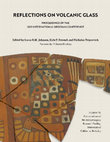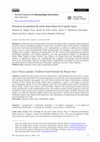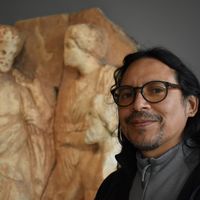Articles by REYNA BEATRIZ SOLÍS CIRIACO

Reflections on Volcanic Glass, 2024
In the Great Temple of Tenochtitlan, archaeologists have recovered more than 1,000 artifacts of c... more In the Great Temple of Tenochtitlan, archaeologists have recovered more than 1,000 artifacts of chipped obsidian, but only 210 pieces of jewelry. Surprisingly, during 43 years of excavations, only one provenance study with Neutron Activation Analysis (NAA) had been carried out on seven objects (five blades, one flake, and one pendant). In this work,
we will present the results of recent analysis with portable X-ray fluorescence (pXRF) applied on 19 obsidian lapidary goods with different morphology, function, temporality, and color. By analyzing the principal components (PCA) of the obsidian artifacts from the Great Temple, compared to geological samples, this statistical study allowed us to
identify 5 of the 10 elements (Y, Rb, Sr, Zr, and Nb) that are the most significant to defining provenance. Based on that, we could determine that most of the samples belong to the main deposits of the Basin of Mexico (Otumba and Pachuca), which is a common sourcing pattern among the assemblages of central Mexico during the Postclassic period
(AD 1200–1521). However, two distinct deposits could be defined better by Hierarchical Cluster Analysis. Thus, three objects came from Pico de Orizaba in Veracruz and one from Ucareo in Michoacan. The interest of the Mexica in the Pico de Orizaba source was important for the military garrisons located about 20 km from the mines. In contrast,
the Ucareo material was an unexpected result because this source was unusual in the Basin of Mexico, most likely due to the dominance of the mine by the Tarascan Empire in West Mexico, one of the principal rivals of Tenochtitlan. This object could be a relic, obtained by looting ancient sites of the Basin of Mexico with prior occupation or as a gift or war prize. Finally, it would be the first reported material originating in that region in
the Great Temple assemblage.

Revista Española de Antropología Americana, 2021
Resumen. En diferentes sitios de Mesoamérica fuera del área Maya se han recuperado objetos lapida... more Resumen. En diferentes sitios de Mesoamérica fuera del área Maya se han recuperado objetos lapidarios de piedra verde de tonalidades brillantes y lustre vítreo, muchos de ellos con decoración o iconografía maya, por lo cual se les han identificado a priori como jadeítas y se atribuye su elaboración a artesanos mayas o que ya vienen manufacturados desde aquella región. Sin embargo, son escasos los análisis detallados que evalúen y confirmen estas propuestas. Por ello, en este estudio mostraremos los análisis tecnológicos aplicados a 243 objetos lapidarios con estas características hallados en Teotihuacan, Monte Albán, Teteles de Santo Nombre, Tula, Tamtoc y el Templo Mayor de Tenochtitlan. De esta manera, se identificó un patrón muy estandarizado que comparte la tecnología artesanal lapidaria maya de las Tierras Bajas. Además, su origen foráneo y distribución restringida hizo que otros grupos mesoamericanos los consideraran bienes de prestigio, emblemas de poder y dones sagrados.
CLIO ARQUEOLÓGICA, 2020
RESUMEN El estudio de bienes lapidarios en la Cuenca de México es un terreno fértil para el conoc... more RESUMEN El estudio de bienes lapidarios en la Cuenca de México es un terreno fértil para el conocimiento de estilos y tradiciones artesanales. Los datos obtenidos con arqueología experimental, microscopia óptica y electrónica de barrido ha permitido proponer la existencia de escuelas artesanales de larga duración. También ha sido posible identificar estilos tecnológicos locales en ciertos asentamientos que difieren de las técnicas y procesos de la lapidaria de la capital tenochca, centro hegemónico por excelencia del periodo posclásico. Ello podría estar indicando un control menos restringido en la obtención, consumo y producción de bienes lapidarios en ciudades nahuas contemporáneas.
EL PALACIO DE XALLA EN TEOTIHUACAN. PRIMER ACERCAMIENTO, 2019
Esferas de producción de los objetos de piedra verde procedentes de las estructuras aledañas al Templo Mayor de Tenochtitlan, 2018
Producción artesanal de objetos de concha en Tula, Hidalgo, 2018
ARQUEOLOGÍA DE LA PRODUCCIÓN, 2018
2014 CHACMOOL CONFERENCE PROCEEDINGS
The majority of the researches about the technology involved in the craft production of lapidary ... more The majority of the researches about the technology involved in the craft production of lapidary objects are based on the reconstruction of the chaîne opératoires through the classification of the by-products, and the associated tools. But, in the case of the pieces found in burials and offerings, the direct evidences of their production were absent. Despite that, it is possible to obtain info about the tools employed in their production through the experimental archaeology and the characterization of the manufacturing traces with Scanning Electron Microscopy. As study case, we chose the lapidary objects from the imperial construction stages of the Great Temple of Tenochtitlan (AD 1428-1521). The results of this analysis allowed us to identify a great technological standardization of certain objects related with Tenochcan Imperial Style.

The Museum of the Great Temple of Tenochtitlan in Mexico City holds a collection of several thous... more The Museum of the Great Temple of Tenochtitlan in Mexico City holds a collection of several thousands of polished stone artifacts that were excavated and identified as temple offerings. These can stratigraphically be related to the sequential construction stages (II-VII) of the ceremonial area of the Aztec capital from the foundation of the city in 1325 to 1521, when the Spaniards conquered the city. A non-destructive investigation of the elemental and chemical composition of these archaeological artifacts helps us to understand the provenance of these pieces, their use and the specific mineralogical choice for these artifacts as well as more information regarding trade routes relevant to the development of the Aztec empire. A mineralogical analysis of, in total, 450 stone artifacts was carried out using infrared spectroscopy (FTIR) and X-ray Fluorescence (XRF). From this, eighty-five pieces were selected according to their excavation location, either in the Great Temple itself or in the surrounding buildings, as well as to represent the different construction stages of the area (this is part of a World Heritage Site). The resulting mineralogical and chemical information was related to possible mineral resources that were controlled and used as the empire expanded. Artifacts made from high-status semi-precious minerals, like jadeite and turquoise, are found to be concentrated in the central buildings and in the Great Temple itself, but also in the later construction periods of the area.











Uploads
Articles by REYNA BEATRIZ SOLÍS CIRIACO
we will present the results of recent analysis with portable X-ray fluorescence (pXRF) applied on 19 obsidian lapidary goods with different morphology, function, temporality, and color. By analyzing the principal components (PCA) of the obsidian artifacts from the Great Temple, compared to geological samples, this statistical study allowed us to
identify 5 of the 10 elements (Y, Rb, Sr, Zr, and Nb) that are the most significant to defining provenance. Based on that, we could determine that most of the samples belong to the main deposits of the Basin of Mexico (Otumba and Pachuca), which is a common sourcing pattern among the assemblages of central Mexico during the Postclassic period
(AD 1200–1521). However, two distinct deposits could be defined better by Hierarchical Cluster Analysis. Thus, three objects came from Pico de Orizaba in Veracruz and one from Ucareo in Michoacan. The interest of the Mexica in the Pico de Orizaba source was important for the military garrisons located about 20 km from the mines. In contrast,
the Ucareo material was an unexpected result because this source was unusual in the Basin of Mexico, most likely due to the dominance of the mine by the Tarascan Empire in West Mexico, one of the principal rivals of Tenochtitlan. This object could be a relic, obtained by looting ancient sites of the Basin of Mexico with prior occupation or as a gift or war prize. Finally, it would be the first reported material originating in that region in
the Great Temple assemblage.
we will present the results of recent analysis with portable X-ray fluorescence (pXRF) applied on 19 obsidian lapidary goods with different morphology, function, temporality, and color. By analyzing the principal components (PCA) of the obsidian artifacts from the Great Temple, compared to geological samples, this statistical study allowed us to
identify 5 of the 10 elements (Y, Rb, Sr, Zr, and Nb) that are the most significant to defining provenance. Based on that, we could determine that most of the samples belong to the main deposits of the Basin of Mexico (Otumba and Pachuca), which is a common sourcing pattern among the assemblages of central Mexico during the Postclassic period
(AD 1200–1521). However, two distinct deposits could be defined better by Hierarchical Cluster Analysis. Thus, three objects came from Pico de Orizaba in Veracruz and one from Ucareo in Michoacan. The interest of the Mexica in the Pico de Orizaba source was important for the military garrisons located about 20 km from the mines. In contrast,
the Ucareo material was an unexpected result because this source was unusual in the Basin of Mexico, most likely due to the dominance of the mine by the Tarascan Empire in West Mexico, one of the principal rivals of Tenochtitlan. This object could be a relic, obtained by looting ancient sites of the Basin of Mexico with prior occupation or as a gift or war prize. Finally, it would be the first reported material originating in that region in
the Great Temple assemblage.
de origen prehispánico tiene muchas vertientes. A nivel nacional
e internacional una gran cantidad de colecciones particulares forman
parte de reconocidos museos públicos o privados, en los cuales hay
grandes cantidades de piezas consideradas como correspondientes
a diversos “estilos prehispánicos” elaboradas a partir de distintos
materiales, tales como cerámica, lítica, hueso, concha y lapidaria.
Muchas de éstas son de una gran belleza y habilidad desplegada
por sus creadores, por lo cual han formado parte de exposiciones
internacionales en diferentes lugares del mundo. Cabe señalar que,
las piezas más apreciadas y valoradas han sido las que presentan
características propias de los estilos o tradiciones más conocidos
del México antiguo: Olmeca, Teotihuacano, Maya, Tolteca, Azteca,
Mezcala, Mixteca-Puebla, Zapoteco, Huasteco, Chupícuaro, Tarasco
y Tumbas de tiro, entre otros.
Tal es el caso de la colección de objetos lapidarios de origen prehispánico
del Museo Amparo, entre sus piezas se reporta una gran
variabilidad de “estilos” de las distintas regiones culturales de México.
Una de las problemáticas que impera en gran cantidad de colecciones
arqueológicas es la asignación de estilos, donde en la mayoría
de los casos, se atribuyen filiación y temporalidad diversas a través
de las similitudes morfológicas y/o estéticas, dándole un gran peso a
esto, pero obviando otros aspectos relevantes como el tecnológico,
lo cual ha complicado el panorama de investigación al tratar de definir
estilos.
Desde esta perspectiva, varios estudios recientes han discutido
la procedencia y manufactura de los objetos, confirmando o refutando
la asignación de estilos foráneos a partir de similitudes morfológicas
y proponiendo el estudio y clasificación de los artefactos tomando
en cuenta su tecnología. Para ello plantean que si provienen de las
supuestas regiones de origen deberían coincidir con las tradiciones
tecnológicas propias de esos lugares, lo cual se apreciaría al comparar
las huellas y procesos de manufactura.
De esta manera el estudio tecnológico, considerado como parte
de la expresión de un estilo, es una alternativa que permite adentrarnos
en las esferas de producción prehispánicas, donde no siempre los
factores externos como el acceso a materias primas y herramientas
determinan las formas elegidas para elaborar objetos; ya que muchas
veces son variables de origen ideológico o preferencia cultural.1
Como se ha visto a través del tiempo, los grupos sociales se han expresado
mediante su cultura material, reflejando en ella su identidad,
su necesidad de marcar y diferenciar estatus, así como para ejercer y
ostentar poder dentro de su grupo o fuera de él.
Desde esta perspectiva, el análisis de material arqueológico como
un reflejo identitario y de filiación de la sociedad permite evaluar distintos
factores relacionados con una gran diversidad de fenómenos:
regionales, políticos, sociales, económicos y religiosos, tanto del grupo
humano al que pertenece, como con su relación y diferenciación
con otras sociedades.2
Por ello, el estudio tecnológico de los objetos lapidarios de la
Colección del Museo Amparo permitió identificar los diversos estilos
presentes en las piezas a partir de la identificación de sus huellas de
manufactura, materias primas y características morfofuncionales. La
colección fue analizada a partir de la comparación y contrastación
con piezas similares recuperadas en contexto arqueológico de diversas
temporalidades y regiones de origen, colecciones de museos
nacionales públicos y privados, así como con piezas de museos del
extranjero. Dicho análisis permitió con un buen nivel de confianza,
poder asignar estilos y temporalidades a las piezas lapidarias del Museo
Amparo.